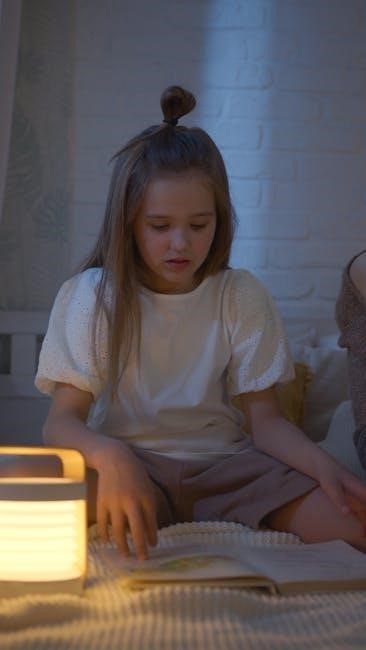The True Story of the Three Little Pigs by Jon Scieszka and Lane Smith is a witty retelling of the classic tale from the wolf’s perspective, offering a fresh twist on justice, media influence, and morality while maintaining its signature humor and charm.
Overview of the Classic Tale and Its Retelling
The True Story of the Three Little Pigs reimagines the beloved fairy tale from the wolf’s perspective, offering a humorous twist. Alexander T. Wolf claims he was misunderstood, framing the pigs as the villains. The story humorously flips the classic narrative, exploring themes of justice, media influence, and morality. With its quirky illustrations and witty dialogue, this retelling challenges readers to question their assumptions about the original tale. It invites a fresh perspective on the timeless story, blending humor with clever storytelling to create a unique literary experience.

The Authors and Their Vision
Jon Scieszka and Lane Smith collaborated to create a unique retelling, blending humor with a fresh perspective, challenging traditional storytelling and offering a wolf’s side of the story.

Jon Scieszka and Lane Smith’s Collaboration
Jon Scieszka and Lane Smith’s partnership brought a fresh, humorous twist to the classic tale. Scieszka’s witty storytelling and Smith’s vibrant illustrations created a unique narrative voice, flipping the traditional perspective. Their collaboration challenged readers to question the original story’s morality, offering a more nuanced exploration of justice and media influence. The duo’s creative chemistry transformed the wolf into a relatable, misunderstood character, making the book a standout in children’s literature. Their work encourages critical thinking and playful engagement with storytelling traditions, leaving a lasting impact on readers of all ages.

The Plot from the Wolf’s Perspective
Alexander T. Wolf shares his side of the story, claiming he was misunderstood. He accidentally blew down the pigs’ houses while trying to borrow sugar for his granny’s cake.
Alexander T. Wolf’s Version of Events
Alexander T. Wolf claims he was framed for eating the pigs, explaining that his actions were misunderstood. He intended to borrow sugar for his granny’s cake but accidentally sneezed, blowing down the houses. The media portrayed him as the “Big Bad Wolf” without hearing his side, highlighting the theme of injustice and biased storytelling. His dietary habits as a wolf were misconstrued, leading to false accusations. This retelling challenges readers to question their assumptions and consider alternative perspectives in this clever twist on the classic tale.

Themes and Moral Lessons
The story explores themes of justice, media influence, and morality, challenging readers to question their perceptions and consider alternative viewpoints in this unique retelling.
Exploring Justice, Media Influence, and Morality
The book delves into themes of justice, media influence, and morality, presenting the wolf’s side of the story to highlight how narratives can be skewed. By framing the wolf as misunderstood, Scieszka challenges readers to question their assumptions about right and wrong. The wolf’s version of events emphasizes the power of media in shaping public opinion, suggesting that truth can be distorted. This narrative technique encourages critical thinking about fairness, blame, and the reliability of information, making it a thought-provoking read for both children and adults alike.

The Book’s Style and Structure
The book features humor, vibrant illustrations, and a unique narrative technique, presenting the wolf’s side of the story in an engaging and playful manner that captivates readers of all ages.
Humor, Illustrations, and Narrative Techniques
Humor shines through Alexander T. Wolf’s witty justifications, while illustrations by Lane Smith add a quirky, visual charm. The narrative cleverly flips the classic tale, presenting the wolf’s side with a conversational tone and playful twists, making it both entertaining and thought-provoking for readers.
Reception and Reviews
The True Story of the Three Little Pigs has received widespread acclaim for its humorous twist and unique narrative perspective. Audiences and critics alike have praised its original storytelling.
Audience Reaction and Critical Acclaim
Audience Reaction and Critical Acclaim

The True Story of the Three Little Pigs has delighted readers of all ages with its fresh, humorous take on the classic tale. Audiences praise its clever storytelling and the wolf’s endearing, misunderstood character. Critics acclaim the book for its originality and ability to challenge traditional narratives. The unique perspective and witty illustrations have made it a favorite in classrooms and homes alike. Its engaging narrative has also inspired adaptations, including puppet shows and stage productions, further showcasing its timeless appeal and universal charm.


The PDF Version and Accessibility
The True Story of the Three Little Pigs is widely available as a downloadable PDF, offering easy access to the humorous tale on various devices, preserving its charm and illustrations.
Downloading and Reading the Book in Digital Format
The PDF version of The True Story of the Three Little Pigs is readily available for download from various sources, including Google Drive and the Internet Archive. This digital format ensures easy access and convenience for readers, allowing them to enjoy the story on multiple devices. The PDF file, part of Jon Scieszka’s collection, is compatible with modern e-readers and mobile devices, making it a versatile option for audiences. It also preserves the book’s humor and vibrant illustrations, providing an engaging reading experience that stays true to the original’s charm.
Educational Value
The True Story of the Three Little Pigs is a valuable educational tool, teaching critical thinking by challenging stereotypes and encouraging empathy through the wolf’s perspective.

Using the Book to Teach Critical Thinking
The True Story of the Three Little Pigs is an excellent tool for fostering critical thinking in students. By presenting the wolf’s side of the story, it challenges readers to question assumptions and consider multiple perspectives. This encourages students to analyze evidence, identify biases, and evaluate the reliability of sources. The book’s humorous and engaging narrative makes complex concepts accessible, helping young learners develop essential skills in reasoning and empathy. Teachers can use this story to spark discussions about justice, media influence, and morality, promoting deeper understanding and open-mindedness in the classroom.
Comparisons to the Original Fairy Tale
The book offers a unique twist by presenting the wolf’s perspective, contrasting the traditional villainous portrayal. It humorously challenges the original story’s assumptions, adding depth and modern flair.
Differences and Unique Aspects of the Retelling
The True Story of the Three Little Pigs diverges from the original by presenting the wolf, Alexander T. Wolf, as a misunderstood character. He claims he was framed and only intended to borrow sugar. The narrative flips the classic tale, offering a humorous and satirical take on justice and media influence. The story’s unique aspect lies in its ability to make readers question their assumptions about the characters and the events, adding layers of moral complexity to the beloved fable.
The True Story of the Three Little Pigs leaves a lasting impact by challenging the traditional narrative, offering a fresh perspective on justice, morality, and media influence.
The Lasting Impact of the Story
The True Story of the Three Little Pigs has left a lasting impact by challenging readers to question their assumptions and consider alternative perspectives. The book’s unique twist on the classic tale encourages critical thinking and sparks discussions about justice, media influence, and morality. Its humorous and engaging narrative, combined with its thought-provoking themes, has made it a beloved and educational resource for readers of all ages. The story’s ability to redefine a villain’s narrative has cemented its place as a modern classic, fostering empathy and understanding in its audience.